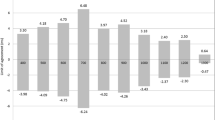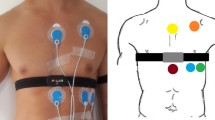Abstract
The aim of this study was to assess the agreement between HRV measures derived from a time series of RR intervals recorded by a standard 12-lead ECG (CP) and a commercially available RR interval recorder (S810). Thirty-three participants (19 males) (median age 36, range 20–63) underwent simultaneous, 5-min, supine RR-interval recordings. Each RR interval time series was analysed using the software supplied with the recording equipment. Two comparisons were then made. First, a comparison of RR interval data recording and editing only was made. Second, comparisons were made for measures of HRV derived from edited RR interval data. Agreement between RR intervals and standard HRV measures were assessed using intraclass correlation coefficient and limits of agreement. Agreement of HRV measures derived from RR intervals recorded and edited by individual systems was not acceptable. Agreement analyses for the number of RR intervals recorded and edited by each systems software showed excellent intraclass correlation coefficients (ICC lower 95% CI > 0.75) and acceptably narrow limits of agreement (LoA). These data indicate that the number of RR intervals recorded by S810 can agree well those recorded from a standard 12-lead ECG. This is true even after application of system specific data editing procedures. Commercial RR-interval recorders may offer a simple, inexpensive alternative to full 12-lead ECG in the recording and editing of RR intervals for subsequent HRV analysis in healthy populations.


Similar content being viewed by others
References
Aubert AE, Beckers F, Ramaekers D (2001) Short-term heart rate variability in young athletes. J Cardiol 37(suppl 1):85–89
Badilini F, Maison-Blanche P, Coumel P (1998) Heart rate variability in passive tilt test: comparative evaluation of autoregressive and FFT spectral analyses. Pacing Clin Electrophysiol 21:1122–1132
Bland JM, Altman DG (1986) Statistical methods for assessing agreement between two methods of clinical measurement. Lancet 8476:307–310
Bland JM, Altman DG (1990) A note on the use of the intraclass correlation coefficient in the evaluation of agreement between two methods of measurement. Comput Biol Med 20(5):337–340
Bland JM, Altman DG (2007) Agreement between methods of measurement with multiple observations per individual. J Biopharmaceut Stat 17:571–582
Carrasco S, Gonzalez R, Jimenez J, Roman R, Medina V, Azpiroz J (1998) Comparison of the heart rate variability parameters obtained from the electrocardiogram and the blood pressure wave. J Med Eng Technol 22(5):195–205
Cerruti S, Golderberer AL, Yamamoto Y (2006) Recent advances in heart rate variability signal processing and interpretation. IEEE Trans Biomed Eng 55(1):1–3
Chemla D, Young J, Badilini F, Maison-Blanche P, Affres H, Lecarpentier Y, Chanson P (2005) Comparison of fast Fourier transform and autoregressive analysis in the study of heart rate variability in diabetic patients. Int J Cardiol 104:307–313
Cottin F, Médigue C, Leptrêtre P-M, Papelier Y, Koralsztein J-P, Billat V (2004) Heart rate variability during exercise performed below and above ventilatory threshold. Med Sci Sport Exerc 36(4):594–600
Fagard RH (2001) A population-based study on the determinants of heart rate and heart rate variability in the frequency domain. Verh Koninklijke Acad Geneeskd Belg 63(1):57–89 (discussion 90–51)
Fagard RH, Pardaens K, Staessen JA et al (1998) Power spectral analysis of heart rate variability by autoregressive modelling and fast Fourier transform: a comparative study. Acta Cardiol 53:211–218
Gamelin FX, Berthoin S, Bosquet L (2006) Validity of the polar S810 heart rate monitor to measure RR intervals at rest. Med Sci Sport Exerc 38:887–893
Hopkins WG (2000) Measures of reliability in sports medicine and science. Sports Med 30(1):1–15
Kingsley M, Lewis MJ, Marson RE (2005) Comparison of polar 810s and an ambulatory ECG system for RR interval measurement during progressive exercise. Int J Sports Med 26:39–44
Lee J, Koh D, Ong CN (1989) Statistical evaluation of agreement between two methods for measuring a quantitative measure. Comput Biol Med 19:61–70
Leicht AS, Allen GD, Hoey AJ (2003) Influence of age and moderate-intensity exercise training on heart rate variability in young and mature adults. Can J Appl Physiol 28(3):446–461
Mortensen S, Lose G, Thyseen H (2002) Repeatability of cystometry and pressure-flow parameters in female patients. Int Urogynecol J 13:72–75
Parati G, Mancia G, Di Rienzo M, Castiglioni P Jr, Talyor A, Studinger P (2006) Point:counterpoint: cardiovascular variability is/is not an index of automatic control of circulation. J Appl Physiol 101:676–682
Pichon A, Roulard M, Antoine-Jonville S, de Bisschop C, Denjean A (2006) Spectral analysis of heart rate variability: interchangeability between autoregressive analysis and fast Fourier transform. J Electrocardiol 39:31–37
Pikkujamsa SM, Makikallio TH, Airaksinen KEJ, Huikuri HV (2001) Determinants and interindividual variation of R–R interval dynamics in healthy middle-aged subjects. Am J Physiol Heart C 280(3):H1400–H1406
Pinna GD, Maestri R, Torunski A, Danilowicz-Szymanowiczm L, Szwochm M, La Rovere MT, Raczak G (2007) Heart rate variability measures: a fresh look at reliability. Clin Sci (London) 113(3):131–140
Sandercock GRH, Bromley PD, Brodie DA (2004a) Reliability of three commercially available heart rate variability instruments using short-term (5-min) recordings. Clin Physiol Funct Imaging 24:359–367
Sandercock GRH, Shelton C, Bromley P, Brodie DA (2004b) Agreement between three commercially available instruments for measuring short-term heart rate variability. Physiol Meas 25:1115–1124
Sinnreich R, Kark JD, Friedlander Y, Sapoznikov D, Luria MH (1998) Five minute recordings of heart rate variability for population studies: repeatability and age–sex characteristics. Heart 80(2):156–162
Task Force (1996) Heart rate variability: standards of measurement, physiological interpretation and clinical use. Task force of the European Society of Cardiology and the North American Society of Pacing and Electrophysiology. Circulation 93:1043–1065
Author information
Authors and Affiliations
Corresponding author
Rights and permissions
About this article
Cite this article
Nunan, D., Jakovljevic, D.G., Donovan, G. et al. Levels of agreement for RR intervals and short-term heart rate variability obtained from the Polar S810 and an alternative system. Eur J Appl Physiol 103, 529–537 (2008). https://doi.org/10.1007/s00421-008-0742-6
Accepted:
Published:
Issue Date:
DOI: https://doi.org/10.1007/s00421-008-0742-6




